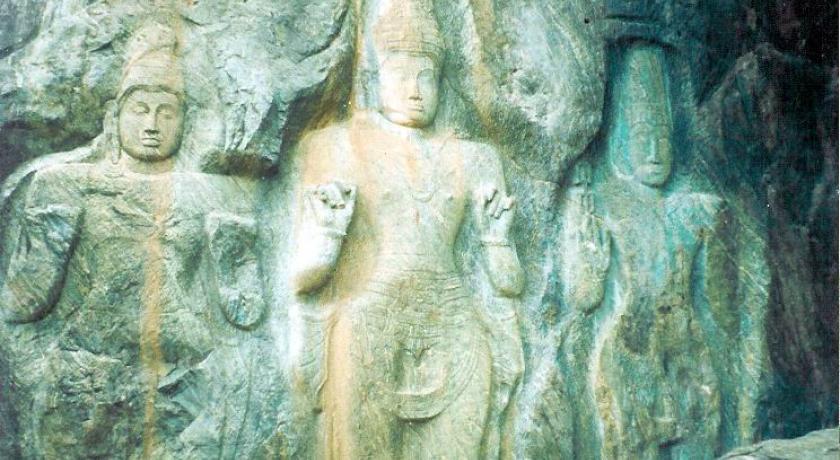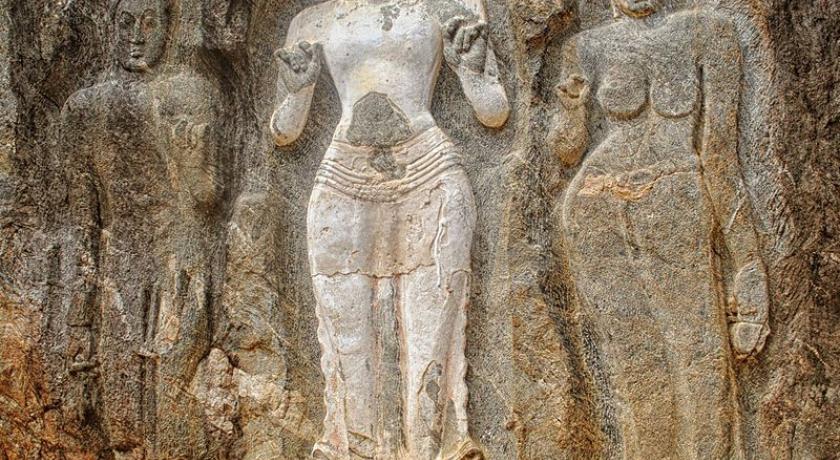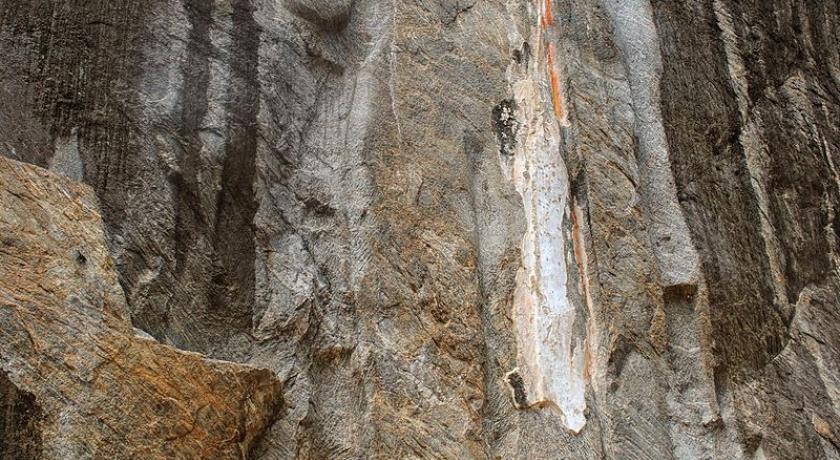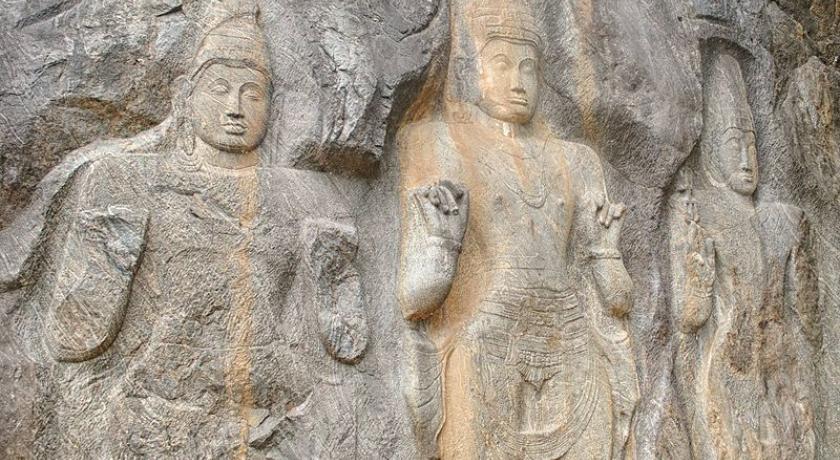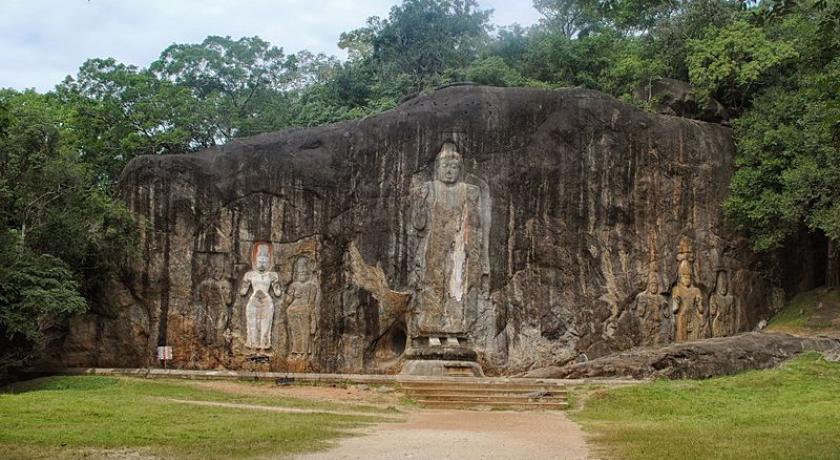Description
Buduruwagala is an ancient buddhist temple in Sri Lanka. The complex consists of seven statues and belongs to the Mahayana school of thought. The statues date back to the 10th century. The gigantic Buddha statue still bears traces of its original stuccoed robe and a long streak of orange suggests it was once brightly painted. The central of the three figures to the Buddha's right is thought to be the Buddhist mythological figure-the Bodhisattva Avalokitesvara. To the left of this white painted figure is a female figure in the thrice-bent posture, which is thought to be his consort-Tara.
Avalokitesvara (the bodhisattva of compassion). To the left of this white-painted figure is a female figure thought to be his consort, Tara. Local legend says the third figure represents Prince Sudhana.The gigantic standing Buddha – at 16m, it is the tallest on the island – in the centre still bears traces of its original stuccoed robe, and a long streak of orange suggests it was once brightly painted. The crowned figure at the centre of the group is thought to be Maitreya, the future Buddha. To his left stands Vajrapani, who holds a vajra (an hourglass-shaped thunderbolt symbol) – an unusual example of the Tantric side of Buddhism in Sri Lanka. The figure to the left may be either Vishnu or Sahampath Brahma. Several of the figures hold up their right hands with two fingers bent down to the palm – a beckoning gesture.
Buduruwagala is located about 5 km from the Wellawaya on the Thanamalwila road. The name Buduruwagala means “the rock with the statue of Buddha” And this is exactly what it is. Seven figured are carved in this rock with a massive 51 foot Buddha statue in the Abhaya Mudra gesture at the centre. The rock it self has shape of a kneeling elephant with its head own. Although there is no documented information about this site in the ancient scriptures, it is now believed this carvings were done during the last days of the Anuradhapura period. (between 8 - 10 Century). These carvings are of the Mahayana Buddhist style and similar to the statues at Dova Temple.
The tallest Buddha statue in the world was the Bamiyan Buddha statues in Afghanistan until the destruction of this ancient monument by the Taliban in March 2001. The Buduruwagala Buddha Statue is now considered the tallest in the world.
The centre statue is flanked by two statues which each about 40 foot in height. These two again flanked by two figures, one female and the other male.The centre figure on the left (as you stand in front) still has most of the plaster and some paint which has been applied by the ancients. This centre figure is thought to be of the figure of Avaloktheeshvara Bodhisattva (the manifestation of all the Buddha’s' compassion in the Mahayana Buddhist teaching - In Theravada Buddhism Avaloktheeshvara is known as Lokesvara). He is identified by the small image of the meditating Buddha in the crown that he wares. This image can be clearly seen the carving. The bare breasted female figure on the right to this is thought be Thara Devi. She is carved in a ‘thivanka’ position (bent in 3 places). The other is thought to be their son Prince Sudana.
On the right is 3 similar figures. And the centre figure is thought to be the Maithri Bodhisattva. He is the fifth Buddha for this eon. On the left is the Vajirapani Bodhisattva ( Sanskrit Vajra : thunderbolt/diamond, Pani : lit in the hand). He is one of the earliest bodhisattvas of Mahayana Buddhism. He is generally represented with a diamond club in his hand)
Name
Buduruvagala means "the rock of Buddhist Sculptures"The name Buduruwagala is derived from the words for Buddha (Budu), images (ruva) and stone (gala) . The figures are thought to date from around the 10th century and belong to the Mahayana Buddhist school, which enjoyed a brief heyday in Sri Lanka during this time.
Location
Buduruvagala is located about 4 miles (6.4 km) southeast of Wellawaya in Monaragala district, Sri Lanka.
Size of the statues
The largest of the standing Buddha statues is 51 feet (16 m) from head to toe; is the largest standing Buddha statue of the island.
History
Authorities generally date them to the 9th or 10th century. Buduruvagala does not have much historical records. Even its original name is unknown. It is thought to be a hermitage for monks. The sculptures of Buduruvagala also include many sculptures of Bodhisattva images including Mahayana tradition
The mustard oil lamp
On the same rock where the sculptures are carved, there is a carved shape of about 3 feet (0.91 m) wide and 4 feet (1.2 m) heigh. It is of the shape of a flame. The inside wall of this carved shape is always wet of an oil that smells very much like Mustard oil. This oil comes to the carved shape with no explainable source or reason.
Address
Buduruvagala
Sri Lanka
Lat: 6.692500114 - Lng: 81.108230591


